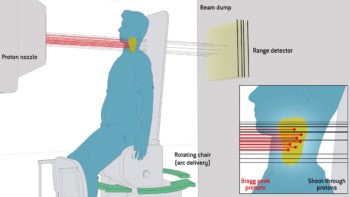
Metrologists enable radiation therapy. These experts in measurement science develop measurement standards and calibrate detectors used in radiotherapy clinics, and when new treatment modalities such as FLASH proton radiotherapy are introduced, they establish accurate dosimetry for those systems.
As detailed in Nature Scientific Reports, metrologists at the National Physical Laboratory (NPL), the UK’s primary standards laboratory, have built a primary-standard proton calorimeter suitable for ultrahigh-dose-rate applications and used the calorimeter to perform dosimetry on FLASH proton beams. The measurement standard has already supported the world’s first clinical trial for FLASH proton radiotherapy.
Calorimetry for conventional proton radiotherapy
Dosimetry for FLASH beams, which deliver radiation quickly using ultrahigh dose rates, is complicated. Ionization chambers, detectors ubiquitous in the radiation therapy community, exhibit ion recombination effects under FLASH beams. As a result, ionization chambers used in FLASH applications require large corrections with large uncertainties that reduce scientists’ confidence in knowing how much radiation dose has been delivered.
“At NPL, we’re trying to disseminate quantities to end users to ensure their standardization, whether that’s schoolchildren using a ruler or us giving radiation to patients for their treatments,” explains Russell Thomas, science area leader of the Medical Radiation Science group at NPL. “The calorimeter is our primary standard, our most accurate detector to measure absorbed dose.”
Calorimeters are dose-rate independent detectors that measure microkelvin-level temperature increases in media hit by a radiation beam. They are typically used to calibrate clinical detectors.
In 2003, NPL started collaborating with physicists at The Clatterbridge Cancer Centre to support improvements in dosimetry for proton radiotherapy, a partnership that ultimately resulted in a graphite calorimeter that could be used for proton beam dosimetry. Thomas and his team have since transported the calorimeter to calibrate conventional proton beams at clinics throughout Europe.
“That initial discussion grew into a 20-year long collaboration that has resulted in us developing not only a world-leading portable primary standard calorimeter for proton radiotherapy but a device that we can use, directly in the clinic, to help standardize radiation dose measurements from promising treatment techniques like FLASH and other light-ion therapies such as carbon and helium beams as they become more widely adopted by the clinical community,” Thomas says in an NPL press release.
Calorimetry for FLASH proton beams
Groups such as Task Group 359 of the American Association of Physicists in Medicine are working to address dosimetry for ultrahigh-dose rate treatments. As these groups review dosimetry standardization for FLASH beams and assess detectors, other researchers want to embark on FLASH proton radiotherapy clinical trials.
In 2020, the NPL researchers took calorimetry measurements of FLASH proton beams at the Cincinnati Children’s Hospital Medical Center. The Cincinnati group, led by medical physics director Anthony Mascia, wanted to quantify the radiation dose delivered by proton beams before starting a clinical trial in patients with bone metastases.
“We just happened to be in the right place at the right time with the right device to go in,” says Thomas.

Applying NPL’s primary-standard proton calorimeter to FLASH proton beams avoided dosimetric errors that could lead to incorrect radiation dose quantification and flawed interpretation of clinical outcomes related to the FLASH effect.
Ana Lourenço, a senior research scientist in NPL’s Medical Radiation Science group, and a team of metrologists and medical physicists collected measurements on the proton therapy centre’s 250 MeV FLASH proton beamline. They also obtained beam-dependent correction factors using Monte Carlo simulations and calculated clinically-relevant absorbed dose to water values from the calorimeter measurements.
The NPL calorimeter measured changes in temperature from the FLASH proton beams on the level of 10 mK. Absolute radiation dose was determined with 0.9% uncertainty (a 1 sigma, or 68% confidence level, result).
“It’s important that when you commission a new facility, or if you want to compare the clinical results between different radiotherapy departments, that the same radiation dose is delivered. These measurements can help underpin the results of clinical trials,” says Lourenço. “In this study, we were able to perform dosimetry at the same level as we do for conventional radiotherapy. This work supported the team in Cincinnati by providing independent verification that the radiation dose they were delivering was correct and gave them the confidence to start clinical trials.”

Compact linac generates ultrahigh-dose-rate X-rays for clinical FLASH radiotherapy
Ideally, Lourenço says, they would also compare measurements from the NPL graphite calorimeter with those from a water calorimeter. This would provide even more confidence that dose conversions are being performed correctly.
The researchers are currently wrapping up an IPEM code of practice for conventional proton beam dosimetry. They are also working with clinical and preclinical research communities, including AAPM and the Varian FlashForward Consortium, to develop dosimetry recommendations for FLASH proton beams.



